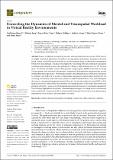| dc.contributor.author | Bernal, Guillermo | |
| dc.contributor.author | Jung, Hahrin | |
| dc.contributor.author | Yassı, İsmail Emir | |
| dc.contributor.author | Hidalgo, Nelson | |
| dc.contributor.author | Alemu, Yodahe | |
| dc.contributor.author | Barnes-Diana, Tyler | |
| dc.contributor.author | Maes, Pattie | |
| dc.date.accessioned | 2024-10-25T16:32:38Z | |
| dc.date.available | 2024-10-25T16:32:38Z | |
| dc.date.issued | 2024-09-26 | |
| dc.identifier.uri | https://hdl.handle.net/1721.1/157422 | |
| dc.description.abstract | Mental workload, visuospatial processes and autonomic nervous system (ANS) activity are highly intertwined phenomena crucial for achieving optimal performance and improved mental health. Virtual reality (VR) serves as an effective tool for creating variety of controlled environments to better probe these features. This study investigates the relationship between mental and visuospatial workload, physiological arousal, and performance during a high-demand task in a VR environment. We utilized a modified version of the popular computer game TETRIS as the task, involving 25 participants, and employed a physiological computing VR headset that simultaneously records multimodal physiological data. Our findings indicate a broadband increase in EEG power just prior to a helper event, followed by a spike of visuospatial engagement (parietal alpha and beta 0-1-3 s) occurring concurrently with a decrease in mental workload (frontal theta 2–4 s), and subsequent decreases in visuospatial engagement (parietal theta at 14 s) and physiological arousal (HRV at 20 s). Regression analysis indicated that the subjective relief and helpfulness of the helper intervention was primarily driven by a decrease in physiological arousal and an increase in visuospatial engagement. These findings highlight the importance of multimodal physiological recording in rich environments, such as real world scenarios and VR, to understand the interplay between the various physiological responses involved in mental and visuospatial workload. | en_US |
| dc.publisher | Multidisciplinary Digital Publishing Institute | en_US |
| dc.relation.isversionof | http://dx.doi.org/10.3390/computers13100246 | en_US |
| dc.rights | Creative Commons Attribution | en_US |
| dc.rights.uri | https://creativecommons.org/licenses/by/4.0/ | en_US |
| dc.source | Multidisciplinary Digital Publishing Institute | en_US |
| dc.title | Unraveling the Dynamics of Mental and Visuospatial Workload in Virtual Reality Environments | en_US |
| dc.type | Article | en_US |
| dc.identifier.citation | Bernal, G.; Jung, H.; Yassı, İ.E.; Hidalgo, N.; Alemu, Y.; Barnes-Diana, T.; Maes, P. Unraveling the Dynamics of Mental and Visuospatial Workload in Virtual Reality Environments. Computers 2024, 13, 246. | en_US |
| dc.contributor.department | Massachusetts Institute of Technology. Media Laboratory | en_US |
| dc.relation.journal | Computers | en_US |
| dc.identifier.mitlicense | PUBLISHER_CC | |
| dc.eprint.version | Final published version | en_US |
| dc.type.uri | http://purl.org/eprint/type/JournalArticle | en_US |
| eprint.status | http://purl.org/eprint/status/PeerReviewed | en_US |
| dc.date.updated | 2024-10-25T13:42:52Z | |
| dspace.date.submission | 2024-10-25T13:42:52Z | |
| mit.journal.volume | 13 | en_US |
| mit.journal.issue | 10 | en_US |
| mit.license | PUBLISHER_CC | |
| mit.metadata.status | Authority Work and Publication Information Needed | en_US |
